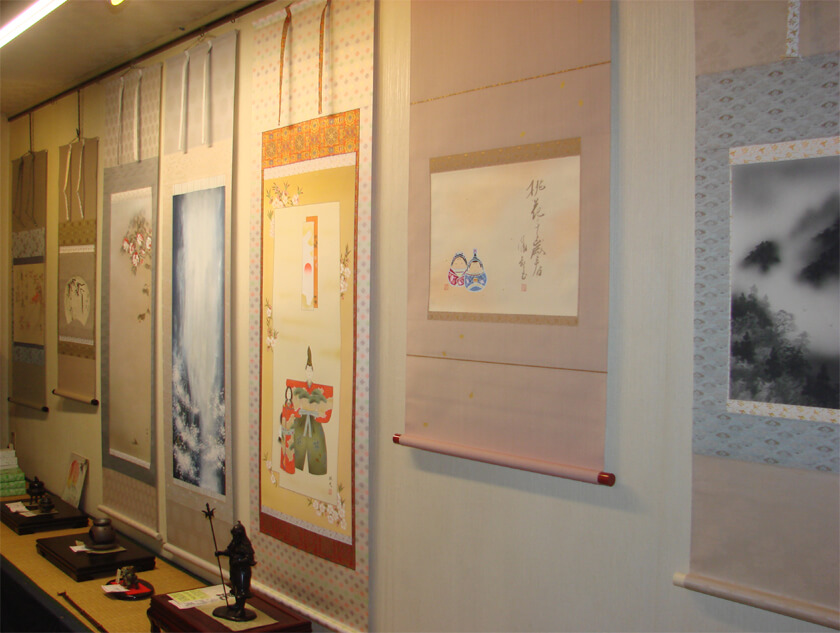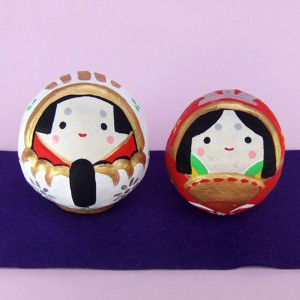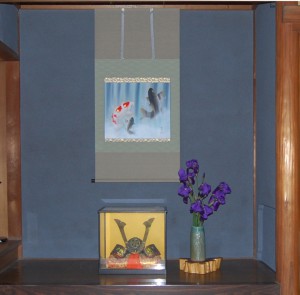Girls’ Festival – Hina-matsuri- in Japan

ART NOMURA Shop View
The New Year’s Holidays passed, so we have changed our gallery’s kakejiku (Japanese hanging scrolls). The kakejiku is normally displayed from earlier than its best season, and we are looking forward to coming the best season. This is a basic rule for enjoying the kakejiku. This is why we mainly displayed nandina, camellias and hina dolls kakejiku. I’ll write a post about girls’ festival (Hina-matsuri) in Japan.
Contents
Hina-Matsuri
“Hina-matsuri” (The Japanese Doll Festival) is an annual event. It is a seasonal festival to pray for the healthy growth of girls. In Japan, Hina-matsuri used to be observed on March 3, of the old calendar (around present-day April). It was on the first day of March ,the Snake month, according to the Japanese lunar-solar calendar. However, after the calendar reform of January 1, 1873, the festival has generally been celebrated on March 3, according to the Gregorian calendar (or new calendar). However, in some parts of Japan, mainly snowy regions such as the “Tōhoku” region, Hina-matsuri is still observed on March 3rd of the old calendar. There are other regions that celebrate the festival on April 3rd, in line with the new calendar. Hina-matsuri was also named “Momo-no-(peach’s) sekku” because the festival, under the old calendar, was held when peach trees blossomed.
Hina-matsuri, girls’ festival, is a seasonal festival in which dolls are displayed, and centering around two dolls representing the emperor, called “obina,” and the empress, called “mebina.” The display is decorated with peach flowers, and people enjoy eating, and drinking “shirozake” (sweet white sake).
During the Edo period, the girls’ “doll play” was combined with the “ceremony of the seasonal festival.” Hina-matsuri spread across the country, and dolls began to be displayed. During this period, however, in addition to the traditional aspects of the doll display, Hina-matsuri increasingly came to have a ritualistic aspect, in which the dolls suffer all of the present and future misfortunes, in the place of people. Also at this time, the Hina-matsuri doll set came to be considered one of the bride’s household articles for high-ranking females, such as the daughters of “samurai” families. As a result, the doll trend became more elegant and luxurious.
Tachibina Dolls Kakejiku
A “tachibina” doll is a hina doll in a standing pose. The kakejiku (hanging scroll) of tachibina dolls is sometimes displayed during Hina-matsuri (girls’ festival). Moreover, the kakejiku sometimes is displayed instead of the Hina-matsuri doll set. Their delicately painted faces are very refined. The elaborate detail of their dresses draws your attention. The entire piece is full of grace, and the kakejiku will accentuate girls’ festival (Hina-matsuri).
Hina Daruma Dolls Kakejiku
Daruma doll, which is a self-righting doll, is popular as a lucky charm. “Hina” Daruma doll is Daruma-doll in obina or mebina shapes.

Hina Daruma Dolls
This work is a collaboration between Suikou Saitou and Houen Kusunoki. The hina Daruma dolls were painted by Suikou Saitou and the calligraphy was written by Houen Kusunoki. The hina Daruma dolls are very pretty and the calligraphy was written with lively brushstrokes. The fluttering flower petals are drawn with gold paint on the mouting fabric. It is very difficult to paint something on mouting fabric. This work is very splendid.
The Kakejiku Is a Nice Souvenir
Many tourists from other countries to Japan look for some souvenir. Is there anyone who is looking for something novel? The kakejiku will surely satisfy the desire. Kakejiku (Japanese hanging scrolls) are Japanese traditional painting art and our company’s main products.

Kakejiku
ART NOMURA Is a Souvenir Shop in Kobe
ART NOMURA, our company, is located at Tarumi-ku ward, Kobe city. The company has produced kakejiku for over 40 years. Although our company is a manufacturing wholesaler, it also sells retail. Recently, kakejiku are becoming popular as rare souvenirs among people from other countries.
ART NOMURA is also a souvenir shop in Kobe. Please, by all means, drop in when you come to Kobe.
About 15 minutes walk from JR Tarumi Station. Also, you can get a taxi in front of JR Tarumi Station.
ART NOMURA
-Souvenir Shop in Kobe-
Address:
7-23, Baba dori, Tarumi-ku ward, Kobe city, Hyogo prefecture, 655-0021, Japan
Business Hour: 10:00 AM to 19:00 PM
Holiday: Sunday (2th and 4th), National Holiday and Monday

